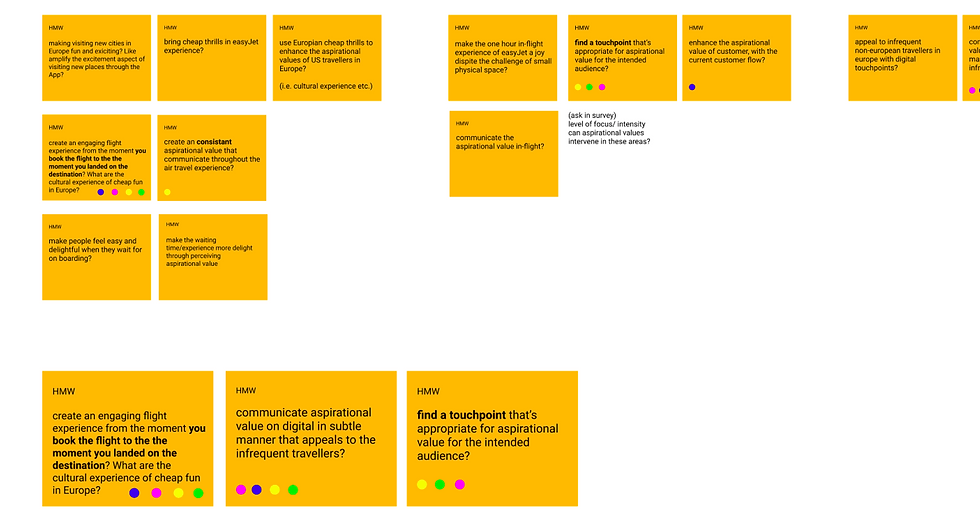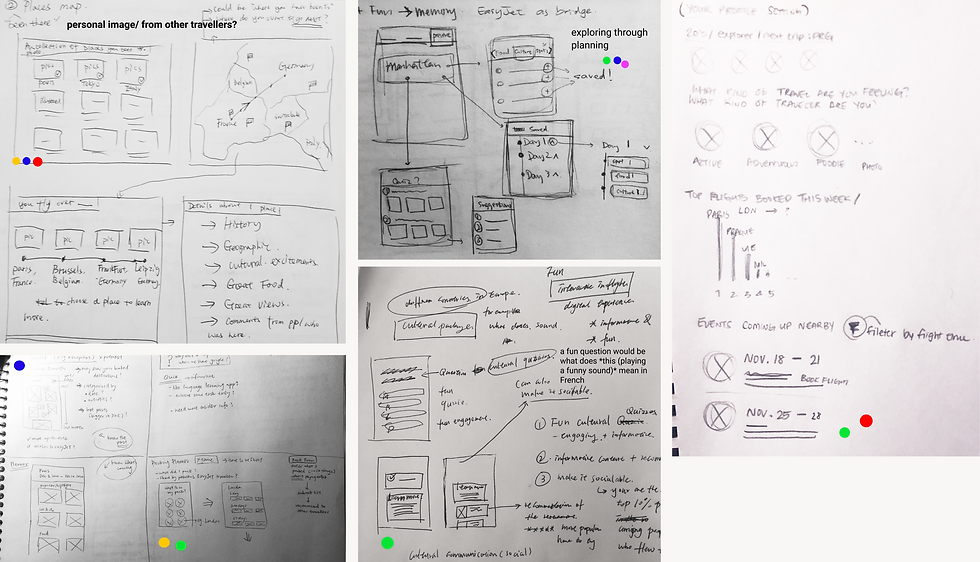Context:
Senior UX design course project.
easyGo pitch video
EasyJet: easyGo
Fun and easy short-trip flight booking for exchange students in Europe.
My Role:
Research, UI/UX design, interaction design, video production.
Duration:
Oct. to Dec. 2020
- 8 weeks
Team:
Alfred Yi Zhang, Alison Chan, Maggie Chan, Sophia Lee.
Context:
Senior UX design course project.
Overview
easyGo is a flight booking website created under the budget airline company - easyJet. It is designed to be the travel companion helping exchange students in Europe to choose short trip destinations in a fun and easy way.
My Role
As I focused mainly on the experience design and interface design of easyGo, I also participated in the market research and user research, the interaction design and the scenario video production.

An easyJet aircraft.
Initial Research
Low-cost airline market
Being able to offer low prices, short-haul flights, low-cost airlines are very popular for travellers in Europe, due to the unique geographic and economic conditions among European countries.
easyJet
As one of the biggest low-cost airlines in Europe, easyJet operates over 900 air routes in more than 30 countries. However, in recent years, easyJet's revenue growth rate has been lower than the competitors.
Insights
To find the business problem, we conducted market research to further understand the low-cost airline industry, such as product audit and competitor analysis, we also sent out surveys to get first-hand opinions from low-cost airline customers.
Research showed that other than low price, customers also value travel efficiency very much; And it appears that although a key segment of customers for the low-cost airline industry are loyal customers that continue to book tickets for membership rewards, a large portion of the survey respondents stated that they are not loyal to any brand when choosing the flights.
Business Opportunity
As the initial research showed, an increasing number of loyal customers
meaning that a low-cost airline will be able to generate more revenue in a long run, which is the key to winning the competition in the low-cost airline industry. And in order to strengthen easyJet's position in the competition, we think the design opportunity lies in strengthening easyJet's brand personality and brand promotion.

easyJet's growth rate compared to other budget airlines.
Brand Pillars
As we compared the research results with easyJet's current brand pillars, we found that some of the brand values stated in the brand pillars, such as the brand personality and promotion are not realized.
.png)
easyJet brand personality and brand promotion provide design opportunities.
Understanding the User
Initial Framing
Based on our discovery in the initial research, we came up with the following framing:
Business Framing:
How might we help easyJet build a stronger customer relationship by strengthening its fun and engaging brand value to advance in the low-cost airline competition?
Customer Framing:
How might we provide engaging and thoughtful service that will entice low-cost airline customers to build a long-term relationship with easyJet?
Target Audience
As the initial market research showed, low-cost airline customers, consist a wide range of groups with various expectations and needs. It is necessary to narrow down and focus on a specific group. Thus, to find the target audience that suits our framing, we conducted rounds of primary and secondary user research, including online surveys and interviews, we received 219 survey responses and 8 interviews in total.
During our research, we discovered a large demographic group that we didn't expect before - the exchange students in Europe.

In one of our surveys, exchange students are the second largest group of travellers.
Some unique travel habits of Exchange students:
+ Stay in a city as the home base for a fixed period (usually from a few weeks to a few months).
+ Price-conscious.
+ Passionate about getting to know different cultures.
+ Fit as many trips as possible to make most of their time in during the exchange program.
+ Prefer short trips (2-3 days) over long trips.
+ Open-minded about travel destinations.
Exchange student is a large customer group of low-cost airline due to their unique travel needs. However, existing low-cost airlines don't seem to pay enough attention or have specific programs facing exchange students. This might be a great opportunity for us to intervene, we believe that by attracting this neglected demographic, we can bring an opportunity for easyJet to attract more loyal customers through strengthening easyJet's unique brand personality and promotion.
Thus, synthesizing the research insights, we modelled a user persona to help guide our design:

Jodie is an easyGo user planning for her next trip in Europe.
Mapping the user journey
By mapping out the exchange student's journey on easyJet's current flight booking system, we can have a better understanding of exchange students' mental models and recognize the consideration stage as the area for our design intervention.

An exchange student's journey on easyJet's existing service
Reframe
We now understand that the major dilemma for exchange students in Europe is that: the cognitive overhead is too high for them to choose a travel destination quickly, while their goal is to travel as many places as they can in Europe.
*connecting the customer framing & business framing: attract the neglected demographic (exchange student) will bring an opportunity for easyjet to build a strong customer relationship that leads to loyalty through expressing a fun & engaging personality.
We can now reframe the question more specifically:
Customer Framing:
How might we provide engaging and thoughtful service that will entice low-cost airline customers to build a long-term relationship with easyJet?
How Might We lower the cognitive overhead* for exchange students to select travel destinations based on their schedule and budget?
*Cognitive overhead: is the effort a person needs to put into doing something.
Ideation
Google Sprint
One of the most effective methods we used during our design process is the Google Sprint, a goal-oriented rapid design method that allows us to validate our design idea within a week.

We brainstormed How Might We questions to set direction for our sprint process.

Quick sketches created sketches to visualize our ideas.

We brainstormed How Might We questions to set direction for our sprint process.
Iteration
Our initial proposed solution is a web application existing on easyJet's website which helps exchange students to select and book flights for trip destinations based on price, distance and themes they are interested in. A Passport feature for collecting travel destinations is also introduced in the solution as a way to facilitate a fun and engaging experience for exchange students. We hoped to provide exchange students with a personalized destination selection process, that is not only efficient but also fun to interact with.
.png)



The initial iteration pages.
User Testing
We conducted 4 online user testings with people who had exchange experiences in Europe. Some of the testers mentioned that they like the holistic perspective of destination selection looks like an "All-in-one app", and how the interface content is well-polished looks like a real product.
However, we received feedback from the teaching staff that our solution is not personalized at all. As it contains a wide range of detailed destinations information and the theme filter system is very generalized which largely resembles existing travel planning products in the market.
And the well-polished prototype used for testing contains too many distractions such as the stock photos that hindered the judgement of the testers.
Final Solution
easyGo user scenario video explains the detailed features of easyGo.
Features
1. Onboarding Process - Fill in Trip Profile
Going through a skippable 3-step onboarding process, exchange students can choose to fill in trip information related to their stay in Europe. Information gathered here will be saved in the system that helps generate tailored destination results in the planning page and overview page.
The Onboarding page
2. the Overview Page - Trip Profile
To help exchange students keep track of their trip progress, we implemented the Travel Profile page. Based on the information users entered for the onboarding questions, they will be able to see their remaining time and budget for travelling Europe at a glance. Quick trip counts estimation and must-visit destination motivates the traveller they can still plan for more trips.
The Trip Profile page
3. the Planning Page - Personalized Flight Booking
To create a tailored destination selecting experience for the exchange students, we minimized the design to focus on their basic preferences: home city airport, price, flight duration and their weekly schedule. destination results will be filtered based on their preferences. With minimized visual elements, an image of the destination will only appear when hovered, so that exchange students won't be overwhelmed and distracted by the appearance of a destination, which helps them to make quick decisions, based on their primary requirements like price, duration and other factors.
The Trip Planning page
Design Decisions
Brand voice
To express easyJet's unique brand personality, and connect the specific target audience - exchange students, the team developed the brand voice for easyGo.
+ Straightforward
Being simple, and get right to the point, minimizing decorations and saving the lengthy wall of text, presenting the necessary content only and direct the exchange students to book flights to their desire destinations fast.
+ Exciting & Explorative
While being straightforward, we also use welcoming and inciting language and interactions to invite the exchange students to explore the destinations they haven't thought about before.
+ Supportive
To be view as a travel companion, easyGo supports exchange students to achieve their travel goals by noting down and keep track of their personalized travel progress encourage them to discover more exciting destinations.
Design system
Expanding on the most signature orange colour of the original easyJet brand, a design system is created based on the easyGo brand voice.

easyGo design system
Reflection
1. User testing doesn't determine the project direction.
I realized that although user testing is very crucial guiding in the design iteration, as designers we should also stick closely to the core mission - framing of the design, instead of accepting all the feedback blindly, we should be considered and filtered out the feedbacks that are relevant to the current focus of the project.
2. The outsider designer perspective
At the beginning of the project, we got feedback from the teaching team and had several pivots, the problem is that we were trying to look for the problems and fix the existing system, instead of bringing the outsider designer's perspective. To form meaningful experience design, we as designers will need to ideate solutions that bridge the need of the users and the goal of the business.
3. "User Experience cannot be designed."
My most important takeaway from this project is to understand that "User Experiencer cannot be designed, we can only design for User Experience.". As our instructor emphasized, user experience is affected by various factors, designers can only DESIGN FOR the experience by understanding the experience, the user, and striving to create designs that exceed expectations.